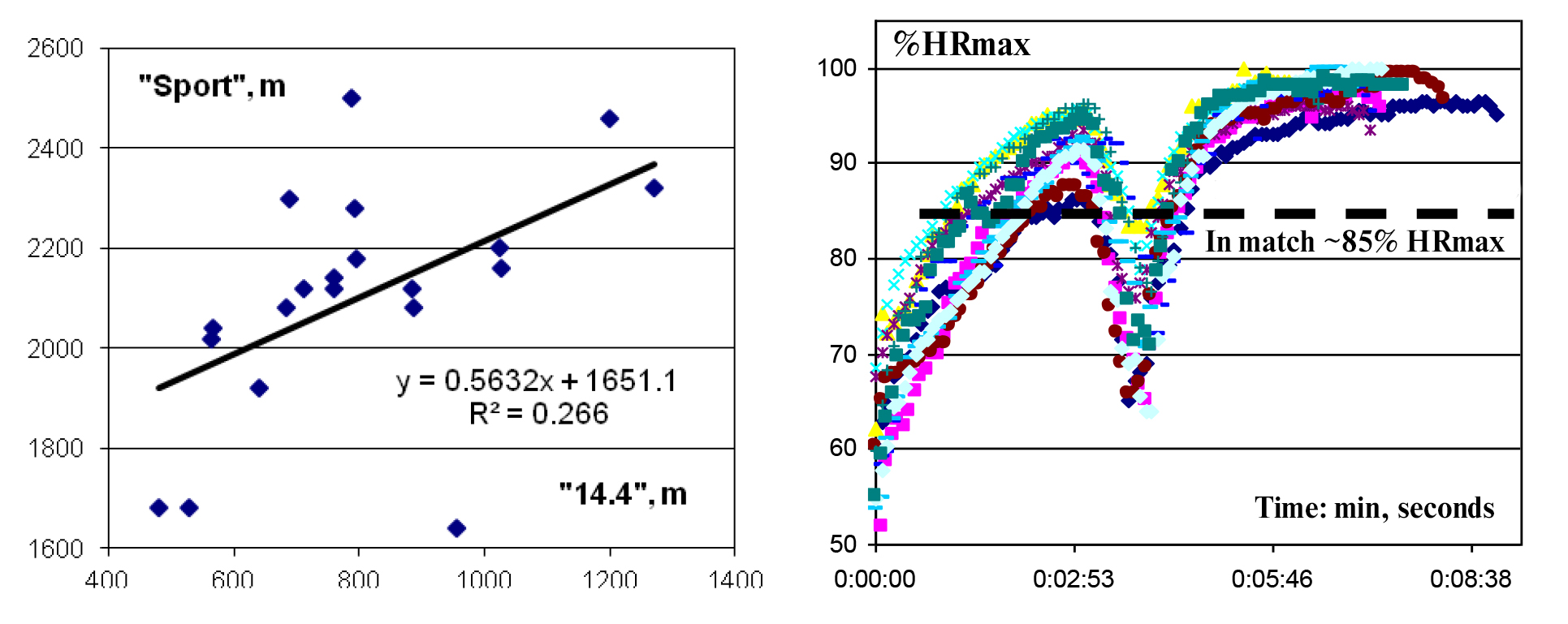Fixed-speed shuttle run effects on physical work capacity and heart rate response rates in Russian national women's football team
Фотографии:
ˑ:
PhD V.M. Alekseev1
S.N. Lavrent'ev2
E.S. Andreeva1
1Russian State University of Physical Culture, Sport, Youth and Tourism (GTSOLIFK), Moscow
2Women's football club "Chertanovo", Moscow
Keywords: physical work capacity, heart rate, shuttle run, peak-test “Sport”, test “14.4”, football.
Introduction. Functionality increase to the maximum is a necessary condition for increasing (or maintaining) physical work capacity at a high level in many sports [3] including modern football [1]. Training tasks like high or very high intensity running with various periods of work and rest, at a permanent or variable speed, a game of football in squares or on small grounds with a limited number of contacts with the ball and many other exercises may be used for this purpose. In this respect it is most important to exceed or at least to reach the level of exertion of physiological reactions recorded during major matches.
Objective of the study was to assess the effect of shuttle run of various speed on heart rate and physical work capacity of football players of the women's national team.
Methods and structure of the study. Twenty outfield players were tested (X, min-max): age – 23.9 years old (18 – 30), height – 1.69 m (1.6 – 1.77), weight – 59.5 kg (52 – 70), body mass index (BMI) – 20.8 (18.7 – 23), heart rate in the morning in a sitting position - 60.1 beats/min (52.1 – 69.7), blood pressure - 111/70 mmHg (96/68 – 130/80). Two tests were carried out on two different days on a football field in a training camp in Novogorsk after 15-minute warm-ups. Test “14.4” is a shuttle run on a ground 40 m long at the speed of 14.4 km/hour till failure to maintain the speed. The test started after a 1-minute rest preceded by running for 3 minutes at the speed of 9; 10.8; 12.6 km/hour (1 minute each) on sports grounds of 25, 30 and 35 m long, respectively. The running speed was set by sound signals produced by an audio system. The other test is a measurement of the maximum aerobic physical work capacity by means of a peak-test “Sport” [2, www.peaktest.ru]. HR was recorded using Polar Team System (5-second recording).
Results and discussion. The distance in the peak-test “Sport” averaged at 2,102 m (1640 m – 2500 m), which corresponds to the estimated MOC of 51.1 ml/kg/min (43.4-57.1). In the “14.4” test the distance was 801 m (480 – 1,272) and the time limit – 200 seconds (120 – 318). The results of these tests (Figure 1) are significantly correlated (r = 0.51; p < 0.05) and can be described by a linear regression equation y = 0.5632x + 1651.1, where “x” is the distance in the test “14.4.”, and “y” is the distance in the peak-test “Sport”.
HRmax in the peak-test “Sport” (n=16) was 195.3 beats/min (183-206). The highest HR in the “14.4” test was 193.6 beats/min (183-206), or 98.7% of the HRmax in the peak-test “Sport”. No one has reached in the “14.4” test the heart rate higher than that in the peak-test “Sport”. Therefore, the value obtained in the peak-test “Sport” was taken as individual HRmax. The average HR during the “14.4” test was 185.4 beats/min, or 94.5% of the individual HRmax. The average HR for the run at 9; 10.8; 12.6 km/hour and during the 1-minute rest pause that preceded the run at the speed of 14.4 km/hour was 72.3; 83.5; 90.5 and 81.7% of the HRmax, respectively. The overall average HR for 3 minutes running, 1 minute rest and the “14.4” test till failure was 87.3% of the HRmax (84.4 – 90.4).
Studies by various authors found that the average HR of adult female football players during a football match is about 85-87% of HRmax [5, 4]. In our study, running at the speed of 10.8 km/hour (83.5% of HRmax), 12.6 km/hour (90.5% of HRmax) and 14.4 km/hour (94.5% of HRmax) was either close to or exceeded the average HR recorded during a football match. Thus, the use of shuttle run of such intensity must have an effective impact on the functional maximal aerobic capacity.

Figure 1. Ratio between distances in the peak-test “Sport” and shuttle run at the speed of 14.4 km/hour “to failure” (n=20)
The overall assessment of the condition of female athletes attending the training camp of the national women’s team can be based on the conceptual triad of “technical and tactical skills” (TTS), “physical condition” (PC) and “psychoemotional state” (PES) (V.M. Alekseev). While the basis of TTS and PES assessment is as a rule formed by expert opinions of the team coaches (head coach), assessing PC using the same approach is too risky. The fact is that PC in women’s football is characterized by noticeable instability that depends primarily on the training methods and characteristics of the matches taking place in clubs just before the training camp as well as their impact on the morpho-functional characteristics of the body and the nature of physical fitness, recovery and nutrition. The most simple and practical way to assess PC of female athletes attending the training camp of the national football team is, in our opinion, to do a direct test of at least maximum physical aerobic work capacity. Based on these data conclusions can be made about physical fitness of a particular athlete for the upcoming match, and the training camp program can be adjusted. The peak-test “Sport” was regularly used for this purpose in the Russian women’s national team in 2013–2015. The functional state of female football players was assessed based on its data, both interindividual and longitudinal changes were compared and analyzed. At the same time practice requires expanding the range of high-intensity training exercises that could be used in two ways: as a means to enhance work capacity and as a method of testing and comparative evaluation of the functional state of the body of various female athletes, especially to address specific tactical tasks.
Conclusions
- Shuttle run on a ground 40 m long at the speed of 14.4 km/hour “to failure” (the “14.4” test) can be used as a means of testing the maximal physical aerobic work capacity of elite female football players as well as a training means of its enhancement. Two factors point to the expediency of using this exercise: 1) a significant correlation with the results shown in the peak-test “Sport” and 2) a high level of the average HR constituting 94.5% of individual HRmax, far exceeding the average pulse response recorded during a football match.
- The “14.4” test can be applied in two ways: a) running at a permanent speed of 14.4 km/hour to failure and b) running at the speed of 14.4 km/hour to failure preceded by running at the speed of 9; 10.8; 12.6 km/hour (1 minute each) and a 1-minute rest. In the latter case, the overall intensity of the load and the average HR (87.3% of the HRmax) are slightly lower than those in the case of a), but higher or the same during a football match.
References
- Alekseev V.M. Fiziologicheskie aspekty futbola (Physiological aspects of football) / V.M. Alekseev. – Moscow: GTsOLIFK, 1986. 24 p.
- Alekseev V.M. PIK-TESTY. Testirovanie fizicheskoy rabotosposobnosti v sportzale, na futbol'nom pole (CD) (Peak-tests. Testing of physical work capacity in gym, on football field (CD) / V.M. Alekseev, E.S. Anokhina. 2011. (www.peaktest.ru)
- Sportivnaya fiziologiya (Sport Physiology) / Ed. by prof. Y.M. Kots. – Moscow: Fizkul'tura i sport, 1986. – 240 p.
- Andersson H.A., Randers M.B., Heiner-Møller A., Krustrup P., Mohr M. Elite female soccer players perform more high-intensity running when playing in international games compared with domestic league games. J Strength Cond. Res. 2010; 24:912-919.
- Krustrup P., Mohr M., Ellingsgaard H., Bangsbo J. Physical demands during an elite female soccer game: importance of training status. Med Sci Sports Exerc. 2005; 37: 1242-1248.
Corresponding author: alexeev2005@mail.ru
Abstract
Subject to the study were the effects of stepped fixed-speed shuttle runs on the heart rate (HR) variations and physical work capacity rates of the Russian national women’s football team athletes (n=20). The study data and analyses found that the maximum run time at 14.4 km/hour (the so-called “14.4 Test») significantly correlates with the Sport Peak-Test (www.peaktest.ru). The average HR in the 14.4 Test was found to make up 94.5% of the individual HRmax that is much higher than the average HR of the adult female footballers during the matches. Therefore, the shuttle runs at 14.4 km/hour performed “to failure” may be recommended as a good way of training to improve the maximum aerobic capacity and a physical work capacity test method in football.



